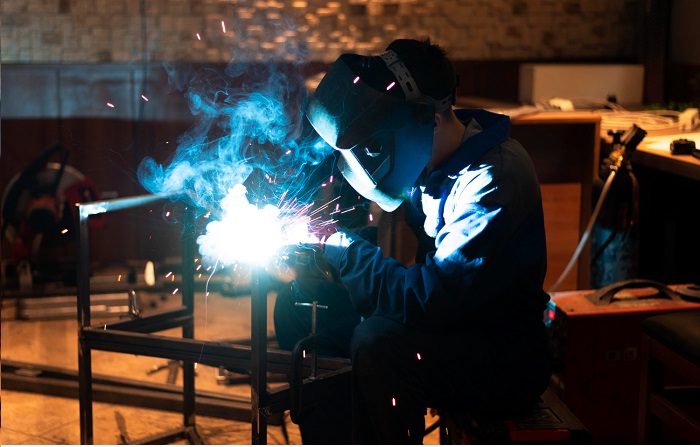For both hobbyist and professional welders, selecting the proper torch is crucial for successful welds. Two of the most common types are air-cooled and water-cooled Welding torches, each with their own sets of pros and cons. Determining if an air-cooled or water-cooled torch is right for your welding application depends on factors like amperage needs, duty cycle, and portability. This guide covers the key differences, advantages, and disadvantages to help choose the best torch type.
Air-Cooled Welding Torches
Air-cooled torches, as the name suggests, use air blown over the torch head to dissipate heat. Built-in fans or external air supplies channel airflow over the torch neck and head to maintain safe operating temperatures.
Advantages:
- Lightweight and portable for mobile applications
- Lower costs and purchase price
- Quick to set up and simple to operate
- Less maintenance without water-cooling systems
Disadvantages:
- Limited amperage capacities due to heat buildup
- Require sufficient airflow and ventilation
- Prone to overheating if used incorrectly
- Not suitable for continuous, high-amperage welding
Best Suited For:
- Low amperage applications (<150 amps)
- Short welding cycles and minimal continuous use
- Portable welding jobs and frequent relocation
- Hobbyists or occasional welding needs
Water-Cooled Welding Torches
Water-cooled torches circulate water, or sometimes a water-coolant mixture, around the torch neck and head. This absorbs substantial heat to enable high-amp, continuous operation.
Advantages:
- Stable arc for quality welds even at 400+ amps
- Built for demanding industrial welding environments
- Can run 100% duty cycle without issues
- No downtime waiting for torches to cool
Disadvantages:
- Heavy and cumbersome for portability
- Higher upfront costs for components
- Complex setup and maintenance
- Potential for leaks and flow problems
Best Suited For:
- High-amperage, continuous welding (200+ amps)
- Applications with 100% duty cycles
- Production environments like pipeline welding
- Professional welders and industrial fabrication
Choosing Between Air-Cooled and Water-Cooled
Assessing your welding needs in terms of amperage, duty cycle, mobility, and operating conditions will determine which torch type makes sense. Lower amperage welding of thin materials can be handled fine with an air-cooled torch. But heavy-duty, high heat welding requires the cooling power and high capacity of water-cooled models.
While water-cooled torches have higher upfront costs, their superior performance translates to long term value for industrial users. For portable applications, an air-cooled torch’s lower price and mobility can’t be beat.
It’s smart to consult experienced welders or a welding supply company to ensure you get the ideal torch for your specific welding requirements. Investing in the right torch improves efficiency, safety, and weld quality for the long haul.
Best Place to Buy Welding Torches – Translas
When shopping for an optimized welding torch for your application, look no further than industry leader Translas. For over 50 years, Translas has supplied top-performing welding torches engineered to the highest standards. They carry a vast selection of premium air-cooled and water-cooled MIG, TIG, and plasma cutting torches to suit any welding need. Their experts can help identify the ideal torch model in terms of cooling, amperage capacity, ergonomics, and accessories. Translas torches are constructed with quality components and designed for durability even under demanding work environments. They stand behind their products with exceptional service and support. For the ultimate torch to help take your welding to the next level, trust the proven selection and customer care that Translas provides.
Conclusion
Selecting the proper welding torch for your needs is a crucial decision. Air-cooled models provide affordability and portability but are limited in amperage capabilities. Water-cooled torches deliver superior performance for demanding, high-heat conditions yet require more involved maintenance. There is no universally “best” option – the ideal torch depends entirely on your specific welding application and environment. Carefully assess your amperage requirements, duty cycle, welding durations, and need for mobility. An informed choice based on how you will use the torch day-to-day will ensure you get equipment matched to your workflows. With the right torch in hand, you can achieve consistent, high-quality welds in a efficient and safe manner. Don’t leave such an important purchase to guesswork. Analyze your welding needs, understand the pros and cons, and make the investment in a torch designed for your work.
You may also like
-
Classified Websites in India: A Digital Marketplace for All
-
Why Sod Installation is the Quickest Way to a Beautiful Lawn?
-
The Role of Statutes and Case Law in Policy Limit Access
-
Setting Up a Home Theater with LG CineBeam Q The Ultimate Guide
-
Business Listing Sites in USA: 2025 Guide for Better Online Visibility

